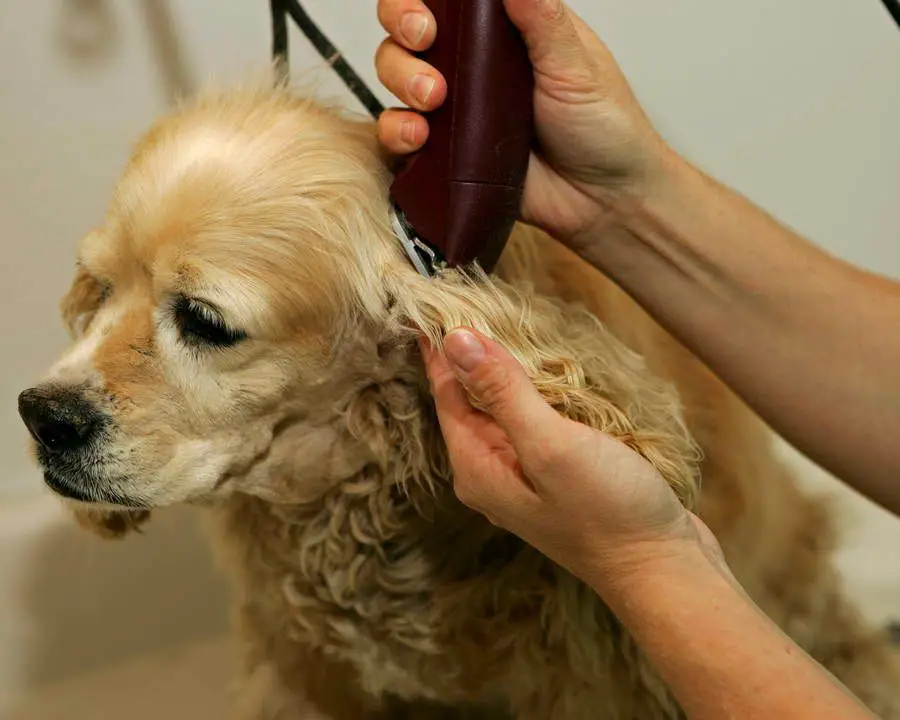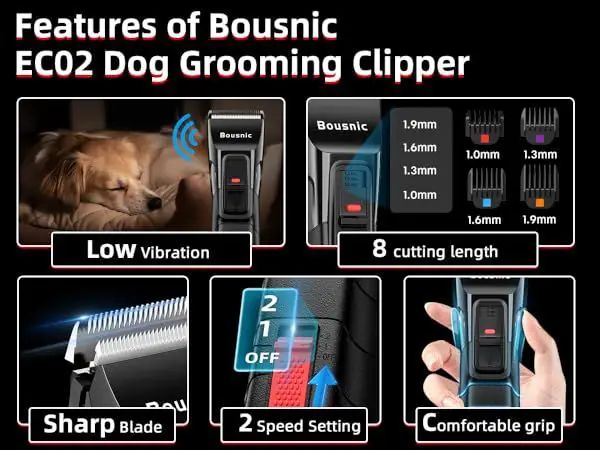Introduction
Choosing the right dog clipper is an important decision for any pet owner. Proper grooming keeps your dog looking and feeling their best. With so many clipper brands and models available, it can be tricky to determine which one is the best choice for your needs.
The goal of this article is to provide dog owners with a comprehensive guide for selecting quality clippers well-suited for their dog’s coat type, thickness, and sensitivity. We will explain the key factors to consider, from clipper power and blade options to noise levels and cordless convenience. Brand recommendations will be provided as well.
By understanding the various features and criteria to evaluate, you will feel confident purchasing clippers that will make grooming safe, easy, and efficient for both you and your dog. The proper clipper will be a valuable investment in your dog’s health and happiness for years to come.
Types of Dog Clippers
There are four main types of dog clippers to consider:
Corded Clippers
Corded clippers are the most powerful option, as they plug directly into an outlet and don’t rely on a battery. This gives them consistent clipping power for heavy duty grooming sessions. They’re a good choice for dogs with thick coats. The cord can limit mobility though.
Cordless Clippers
Cordless clippers offer greater flexibility and range of motion since there’s no cord attached. They run on rechargeable lithium-ion batteries. Battery life depends on the model, but often provides 60+ minutes of run time. Cordless clippers are convenient but may lack power for thicker coats.
Detachable Blade Clippers
Clippers with detachable blades allow you to switch out the blade sets. This makes it easy to adjust the blade length and customize the cut for different parts of your dog’s body. Detachable blades are versatile but can be more expensive upfront.
Fixed Blade Clippers
Fixed blade clippers have a blade set that is permanently attached and not interchangeable. They’re often more affordable but less versatile, since you can’t swap out blades. Fixed blades work well for shorter all-over trims.
Coat Type Considerations
A dog’s coat type and thickness is one of the most important factors in choosing the right clipper. Thicker, denser coats require more powerful motors and sturdier blades than thinner, finer coats. Similarly, longer coat lengths may need clippers with wider blade sweeps to work more efficiently.
For dogs with thick, dense coats like Golden Retrievers, German Shepherds, Chow Chows, and Siberian Huskies – look for clippers with motors of at least 3,000 SPM. The extra power will prevent the motor from bogging down in thick fur. Opt for high quality stainless steel blades, as thicker coats can dull cheaper steel over time.

Dogs with fine, thin coats like Dobermans, Boxers, Dalmatians, and Greyhounds often do well with lighter duty clippers around 2,000 SPM. The blades don’t need to be as heavy-duty either. This helps keep the clippers light and prevents irritation on the dog’s sensitive skin.
In terms of coat length – dogs with longer coats generally require clippers with wider blade sweeps to cover more fur in each pass. A good guide is:
- Under 1″ coat – blade width of 1/8″
- 1″-3″ coat – blade width of 3/8″ to 1/2″
- Over 3″ coat – blade width of 5/8″ or greater
Making sure to match your clipper’s blade width to your dog’s coat length will help achieve a smooth, efficient cut.
Clipper Power
When selecting a dog clipper, it’s important to consider the power or wattage of the motor. This will determine how well it can cut through your dog’s coat, especially for thick or long hair. Corded clippers are rated by wattage, while cordless clippers use voltage as the power measurement.
For small or short-haired dogs, a clipper with lower power around 5-15 watts or 2-4 volts is usually sufficient. Medium dogs with thicker coats will need a clipper with 20-40 watts or 4-5 volts. For large breed dogs with very thick undercoats like Golden Retrievers or Husky breeds, look for heavy-duty clippers with 40+ watts or 5+ volts.
You want the clipper to be powerful enough to easily glide through the coat without getting slowed down or overheated. If you have to go over the same spot repeatedly, it’s a sign the clipper lacks the power for the coat type. Getting a clipper with too little power can result in uneven cuts, overheating, and excessive noise.
At the same time, higher power doesn’t necessarily mean better performance. Extremely powerful clippers may be too harsh on sensitive skin and can burn a dog if used incorrectly. Find an appropriate balance based on your dog’s size and coat thickness.
Blade Options
Clipper blades come in a variety of sizes and grades to suit different coat types and cutting lengths. Understanding the differences between blade sizes and types is important for achieving the desired cut.
Standard blades are sized from #40 to #4, with the higher numbers used for shorter cuts and lower numbers for longer cuts. For example:
- #40, #50, #60 blades: Leaves 1/100″ (0.25mm) length, best for smooth coated breeds like Dobermans or Boxers
- #15, #30 blades: Leaves 1/16″ to 1/50″ length, best for short single coats like Pit Bulls or Labs
- #10 blade: Leaves 1/8″ length, commonly used for longer single coats like Golden Retrievers
- #7, #5 blades: Leave 1/4″ to 1/2″ length, good for maintaining medium coats
- #4 blade: Leaves 5/8″ length, suitable for longer coats and trimming feathering
For dogs with thick double coats like Collies and Pomeranians, skip blade sizes and use a snap-on comb attachment for maximum coat lift and an even cut. There are also different blade grades – carbon steel stays sharp longest but requires more cleaning, while ceramic blades heat up less and stay smoother.
Cordless vs. Corded
When choosing between cordless and corded dog clippers, there are some key factors to consider:

Cordless Clippers
Pros:
- Completely portable and wireless for ease of movement and use anywhere.
- Lightweight designs make them easy to maneuver around dogs.
- Rechargeable lithium-ion batteries provide decent run times between charges.
- No cords getting in the way or limiting your reach.
Cons:
- Have to recharge battery after a certain amount of use.
- May eventually experience reduced battery life after repeated recharges.
- Cannot use while recharging.
Corded Clippers
Pros:
- Unlimited runtime when plugged into an outlet.
- Often more powerful with higher torque and cutting speeds.
- Don’t have to worry about maintaining a battery.
Cons:
- Limited mobility due to being tethered to an outlet by the cord.
- Cord can get tangled or in the way during use.
So in summary, cordless offers greater convenience and portability but corded provides unlimited runtime and often more power. Consider your needs and preferences to decide which is a better fit.
Noise Level
When selecting a dog clipper, consider how much noise it makes during operation. This is especially important if you have a dog that is easily spooked or very sensitive to sounds. A loud, buzzing clipper can be stressful or frightening for some dogs.

Look for a clipper that is designed to run quietly. High quality motors usually generate less noise. Also check the decibel rating if it’s listed in the product specifications, with lower decibels meaning a quieter motor.
Some other features that can reduce noise are:
- Rubberized grips or housing materials that muffle vibration
- Noise dampening technology built into the motor
- Vents or mufflers that decrease air noise
Test out the noise level in person if you can by asking a sales associate for a demo. Or watch video reviews that demonstrate how loud the clipper is during use on a dog.
Choosing a quiet clipper will help make grooming less stressful and more comfortable for timid dogs. This can make the experience better for both you and your furry friend.
Additional Features
When shopping for dog clippers, there are a variety of useful additional features to consider:
Adjustable Speeds – Many clippers allow you to adjust the speed at which the blade moves. This gives you more control and flexibility based on your dog’s coat type, thickness, and sensitivity. Faster speeds work well for thick or matted coats, while slower speeds help prevent irritation on sensitive skin.

Detachable Blades – Detachable blade systems allow you to switch out the clipper blades as needed. This expands the number of coat lengths you can achieve with one clipper. Many clippers come with multiple blades, while some allow you to purchase compatible blades separately.
Cordless Operation – Cordless clippers offer greater mobility and convenience, since you don’t have to worry about maneuvering a cord while moving around your dog. Cordless clippers are powered by a rechargeable battery that typically offers 60 to 80 minutes of run time.
Quiet Operation – Look for clippers designed to run quietly if your dog is prone to being startled or scared by noise. Quieter motors cause less vibration and disturbance.
Accessories – Useful accessories include cleaning brushes, blade oil, combs for different lengths, storage cases, and charging stands. This allows you to maintain your clippers and get more versatility from them.
Consider your needs and preferences to decide which additional features are most important for your clipping sessions.
Top Brands
When it comes to the top dog clipper brands on the market, here are a few stand-outs to consider:
Andis
Andis is one of the leading brands when it comes to dog grooming clippers. Their UltraEdge Super 2-Speed Detachable Blade Clipper is an excellent choice for heavy-duty clipping and provides maximum control and flexibility thanks to its adjustable blade speeds.
Wahl
For over 100 years, Wahl has been manufacturing professional-quality grooming tools. Their Motion Lithium Ion Cordless Animal Clipper is a top pick, providing up to 90 minutes of cordless runtime per charge and coming with multiple attachments for versatile grooming needs.
Oster
Oster is synonymous with sturdy, reliable clippers suited for all coat types. The Oster Volt Cordless Clipper offers exceptional clipping power with whisper-quiet operation. It’s lightweight yet durable, making grooming sessions comfortable and efficient.
Conclusion
When choosing the right dog clipper, there are a few key factors to consider:
– Your dog’s coat length and thickness – Thicker coats require more powerful motors, while sensitive skin may need a quieter clipper.
– Cordless or corded – Cordless gives flexibility but may have less power. Corded is stronger but less portable.
– Blade types – Different blades suit various lengths of hair. Detachable blades allow more customization.
– Noise level – Quieter clippers reduce stress for anxious dogs.
– Brand reputation – Stick to well-known brands for reliability and safety.
– Special features – Look for adjustable speeds, detachable heads, or accessories if needed.
Choosing the right clipper for your dog’s specific needs will make grooming easier and more effective.